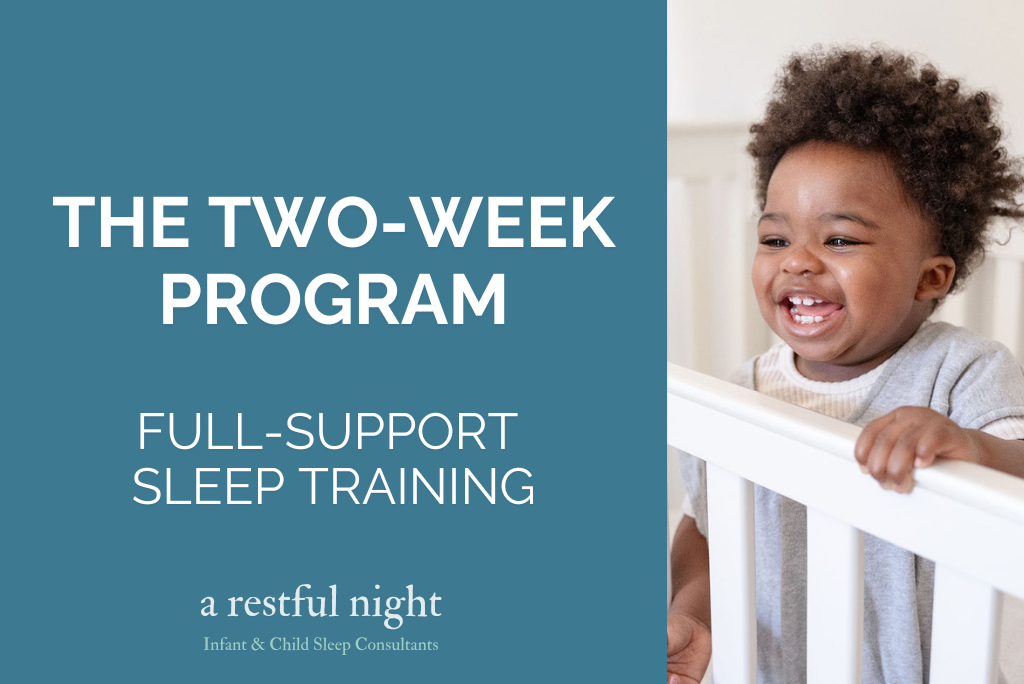The Check and Console Method: Sleep Training Explained
The Check and Console Method - also known as the Ferber Method, Timed Intervals or Controlled Crying - comes with a few different names. (No wonder new parents feel overwhelmed, right?) But don’t worry, those rotating titles are probably the most confusing part about it!
This straightforward sleep training approach is perfect for the practical parent: someone who understands that crying is a natural part of learning new skills, but still wants to offer their child a more supportive transition to independent sleep than Cry It Out. (And no shade to Cry It Out, or full extinction, every family is different, and what works for one may not work for another!)
If you're looking for a middle-ground between hands-off methods and constant monitoring & rocking, the Check and Console Method might be the sweet spot for your family. The Check and Console Method can be used alone - or as the natural next step to more assisted methods like the Chair Method (shall I blog about this one next?!).
It offers a balanced way to help your little one build independent sleep skills while still feeling supported. Instead of leaving them to cry it out completely, you check in at gradually increasing intervals to reassure them, helping them feel secure as they learn to fall asleep on their own.
How Does the Check and Console Method Work?
The Check and Console method is a sleep training approach where parents check on their child at scheduled intervals, providing brief reassurance (such as a gentle pat or a few comforting words) before leaving the room. Over time, the intervals between check-ins gradually increase to encourage independent sleep. This method is effective because it balances the ability for a parent/caregiver to intervene while still giving the child space to “sort it out” and develop their skills independently!
Here are the steps to make the Check and Console Method work for you:
Put your child down 100% awake. If you’re rocking or cuddling your little one to sleep beforehand, you’re missing the chance to help them develop independent sleep skills. If your child can’t go from fully awake to fully asleep on their own, they haven’t yet learned how to sleep independently—but don’t worry, that’s what we’re here to teach!
Say goodnight and leave the room. We encourage parents to use the same parting phrase every night, like a song (our preferred option), a prayer or consistent phrase such as or: “Goodnight, [name], Mommy loves you very much, I’ll see you in my dreams.” This consistent cue, paired with your bedtime routine, helps signal to your child that it’s time for sleep and brings a sense of predictability and comfort.
Next Watch, Wait and Listen. Giving your child space to learn to fall asleep is incredibly important. Observe their body language and what they are doing also assess what their crying sounds like. If you are seeing a calm body with rhythmic, occasional crying, just stay in watch mode! If you are seeing escalated crying go ahead and start your first interval, giving your child 5-10 minutes to “try” based on what you are comfortable with.
Check in at = intervals. If your child stays escalated, let your interval timer run and then go and reassure your child with a soft pat or a calm, gentle voice, but don’t make a big production out of it. The goal here is to be cool, calm, and collected. Don’t expect your child to fully calm when you go in. The goal is to reassure them, let them see you and give them another chance to try!
Gradually increase the time between check-ins. Stretch the intervals bit by bit—five minutes, then ten, then fifteen—until your child drifts off to sleep on their own without check ins!
Keep check-ins brief and soothing. Avoid picking them up or engaging in lengthy interactions. A few comforting words with some rhythmic shhh patting is enough to let them know you’re nearby.
Observe your baby’s response. Some babies find check-ins comforting, while others may become more upset. If your child seems more distressed, you can adjust the approach to better suit their needs. You don’t want to get into a routine of “rescuing” your crying child - which can deepen their reliance on you, and lead to a sense of anxiety being alone in their room!
This method helps children build self-soothing skills while still feeling your presence nearby. The Check and Console Method can take a little longer and requires more hands-on involvement from parents—hence its nickname, “gradual extinction.” But with consistency and patience, your little one will grow more confident and independent, and begin to love their bedtime routine!
How long does the Check and Console method take to work?
The Check and Console method typically takes between a few nights to a week to see results. Progress happens gradually, with your child gaining more independence over time. Staying consistent is key to ensuring success.
When to Use The Check and Console Method?
The Check and Console Method is ideal when your baby is ready to start learning independent sleep skills but still benefits from a little comfort along the way.
It’s a wonderful middle-ground for parents who:
Want a more hands on approach with the ability to reassure their child as needed
Have a baby who gets overstimulated by too much parental presence—some little ones find constant interaction too exciting!
Prefer a flexible method that allows them to follow their child’s cues rather than sticking to strict rules
Are looking to help their baby fall asleep independently—without feeling like they have to “tough it out”
Are able to really look for progress during intervals to know if their baby is getting somewhere
Have the time and energy for a slightly longer and more involved sleep training process
When should you start sleep training?
We support babies as young as 14 weeks through our Two Week Full Support Sleep Training Program! The earlier you begin, the easier it often is for your baby to settle into a new routine—but rest assured, it’s never too late for your child to build healthy sleep habits.
It might be time to try the Check and Console Method if your baby:
▫️ Struggles to fall asleep independently
▫️ Wakes frequently throughout the night
▫️ Relies on rocking, feeding, or bouncing to fall asleep
▫️ Experiences short, unpredictable naps
If this sounds familiar, the Check and Console Method could be the gentle, supportive solution your family’s been looking for.
Tips to Make the Check and Console Method Work for Your Baby
Want to make the most out of the Check and Console Method? Here’s how to set your little one up for sleep success (and finally get some rest yourself!):
Be Consistent
Babies thrive on routine! Stick to a predictable bedtime pattern so they know when it’s time to fall asleep—same time, same steps, every night.
Maintain Your Sleep Cues
Maybe it’s a lullaby, the scent of their bubble bath, or the same setting on their Hatch Light every night. The repeated use of sleep cues help build your child’s sleep routine, and give their brain the signal that it’s time to rest.
Create a Comforting Sleep Environment
Think of it as setting the scene for the perfect snooze. Dim the lights, use white noise, and make sure their sleep space is cozy and distraction-free. A calm space = a calm baby.
Practice Gradual Intervals
Start small! In the beginning, check-in after just 3-5 minutes. Then, slowly stretch the time between check-ins so your baby can start falling asleep independently without assistance.
Stay Calm & Reassuring
Children are emotional sponges. If you stay relaxed and confident, they’ll feel secure knowing you’re close by. Nervous energy from Mom or Dad might confirm their suspicions that being alone in their room is scary!
Have Some Flexibility
No two babies are the same, and that’s okay! Some will need more check-ins, while others might get overstimulated if you pop in too much. Adjust based on monitoring the baby’s response, and remember—you know your child best!
Work with a Sleep Consultant
Certified sleep experts like my team at A Restful Night are here to support you every step of the way. With training and experience in a variety of sleep methods, we can help you choose the best approach for your family and create a personalized plan to implement it successfully!
Common Challenges with the Check and Console Method & How to Handle Them
Every baby is different, and sleep training isn’t always smooth sailing. But don’t worry—you’ve got this! Here’s how to handle the most common hiccups:
Your child cries even more after check-ins
Uh-oh, your little one is getting more worked up instead of calming down! Some babies get upset seeing you come and go. Try tweaking your approach:
☑️ Keep check-ins short and sweet—a quick pat, a soft "shhh," then leave (no more than 45-60 seconds)
☑️ Avoid too much talking or eye contact—it might excite them instead of soothing them.
☑️ ️Experiment with longer intervals between check-ins to give them more time to self-soothe.
They still struggle to fall asleep
If your baby is tossing, turning, and fussing for too long, overtiredness could be the culprit. Check their nap schedule, and make sure they’re getting the right amount of sleep for their age! Hint: we have age specific sleep schedules up for grabs HERE.
☑️ Too much awake time before bed? Try an earlier bedtime.
☑️ Too many long naps? Gently adjust their daytime sleep to balance it out.
☑️ A soothing pre-bed routine (warm bath, dim lights, snuggles) can help them wind down.
It’s taking longer than expected
Some babies adjust in just a few days, while others need a little more time.
☑️ Stick with the method for at least a week. Remember, it takes time to build a new skill!
☑️ Keep track of progress—small wins count! Celebrate it!
☑️ If things aren’t improving, adjust. Maybe your baby needs a more gradual transition.
Remember two words: Flexibility and commitment! Keep tweaking and soon your little one will hit their best sleep ever!
Final Thoughts
Sleep training isn’t one-size-fits-all. The Check and Console Method, offers a gentle and supportive way to guide your baby towards independent sleep. This method balances minimal intervention with reassurance, often with less crying and a stronger sense of security at bedtime.
Are you ready to help your baby fall asleep independently? Give this method a try! And as always, if you need a teammate to coach you through the transition, we’ve got you covered!
Meg O'Leary is an Infant and Child Sleep Expert and the founder of A Restful Night. Based in Westchester County, NY, she leads a team of certified sleep coaches to provide virtual support to families across the US and around the world.






